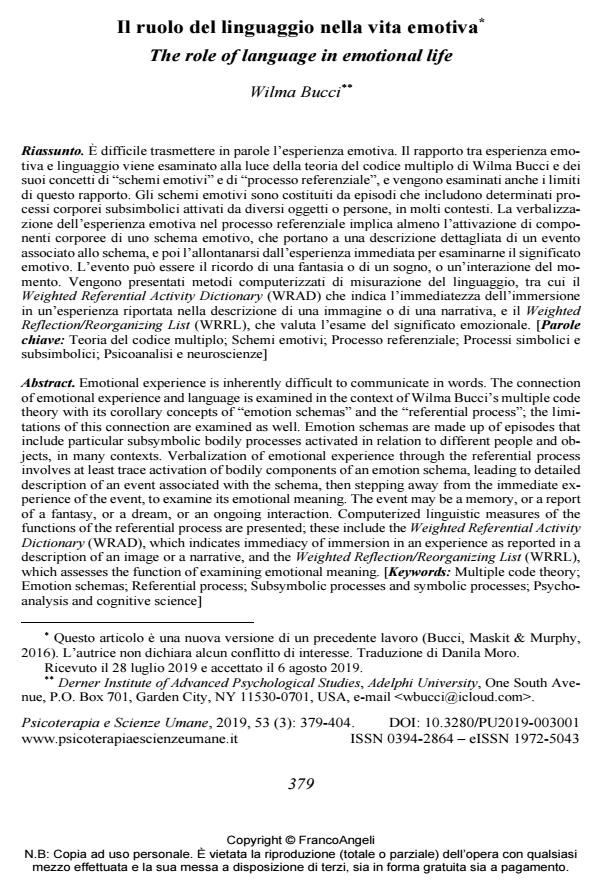Il ruolo del linguaggio nella vita emotiva
Titolo Rivista PSICOTERAPIA E SCIENZE UMANE
Autori/Curatori Wilma Bucci
Anno di pubblicazione 2019 Fascicolo 2019/3
Lingua Italiano Numero pagine 26 P. 379-404 Dimensione file 233 KB
DOI 10.3280/PU2019-003001
Il DOI è il codice a barre della proprietà intellettuale: per saperne di più
clicca qui
Qui sotto puoi vedere in anteprima la prima pagina di questo articolo.
Se questo articolo ti interessa, lo puoi acquistare (e scaricare in formato pdf) seguendo le facili indicazioni per acquistare il download credit. Acquista Download Credits per scaricare questo Articolo in formato PDF

FrancoAngeli è membro della Publishers International Linking Association, Inc (PILA)associazione indipendente e non profit per facilitare (attraverso i servizi tecnologici implementati da CrossRef.org) l’accesso degli studiosi ai contenuti digitali nelle pubblicazioni professionali e scientifiche
È difficile trasmettere in parole l’esperienza emotiva. Il rapporto tra esperienza emotiva e linguag-gio viene esaminato alla luce della teoria del codice multiplo di Wilma Bucci e dei suoi concetti di "schemi emotivi" e di "processo referenziale", e vengono esaminati anche i limiti di questo rap-porto. Gli schemi emotivi sono costituiti da episodi che includono determinati processi corporei subsimbolici attivati da diversi oggetti o persone, in molti contesti. La verbalizzazione dell’esperienza emotiva nel processo referenziale implica almeno l’attivazione di componenti cor-poree di uno schema emotivo, che portano a una descrizione dettagliata di un evento associato allo schema, e poi l’allontanarsi dall’esperienza immediata per esaminarne il significato emotivo. L’evento può essere il ricordo di una fantasia o di un sogno, o un’interazione del momento. Ven-gono presentati metodi computerizzati di misurazione del linguaggio, tra cui il Weighted Referen-tial Activity Dictionary (WRAD) che indica l’immediatezza dell’immersione in un’esperienza ri-portata nella descrizione di una immagine o di una narrativa, e il Weighted Reflec-tion/Reorganizing List (WRRL), che valuta l’esame del significato emozionale.
Parole chiave:Teoria del codice multiplo; Schemi emotivi; Processo referenziale; Processi simbolici e subsimbo-lici; Psicoanalisi e neuroscienze
- Sul rinnovamento della psicoanalisi Giorgio Meneguz, in PSICOTERAPIA E SCIENZE UMANE 2/2023 pp.213
DOI: 10.3280/PU2023-002003 - The problem of validation of psychotherapy Paolo Migone, in PNEI REVIEW 1/2025 pp.1
DOI: 10.3280/pnei2025oa19416
Wilma Bucci, Il ruolo del linguaggio nella vita emotiva in "PSICOTERAPIA E SCIENZE UMANE" 3/2019, pp 379-404, DOI: 10.3280/PU2019-003001